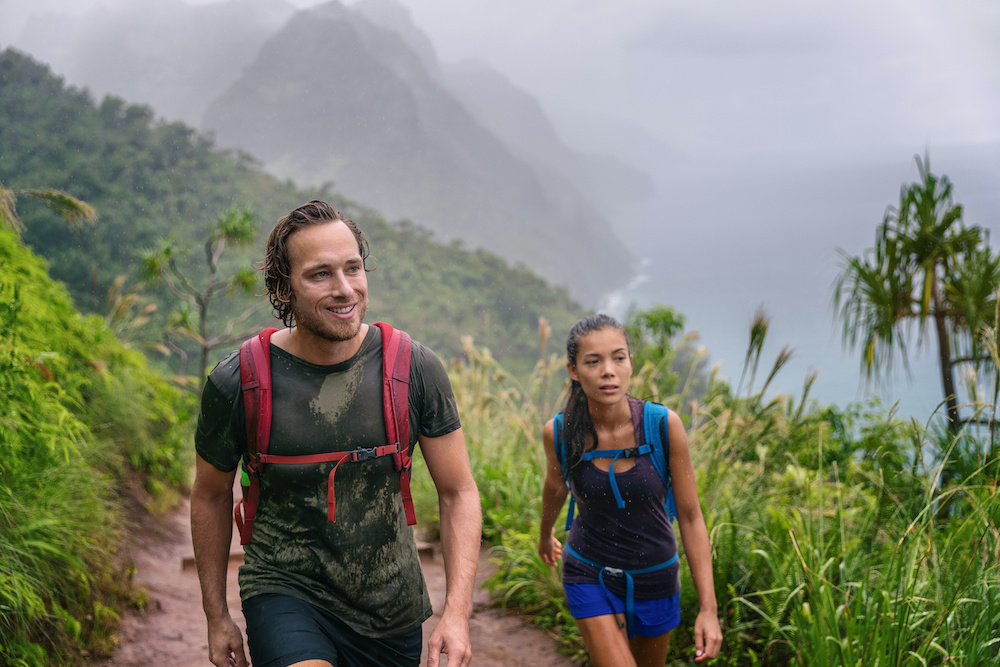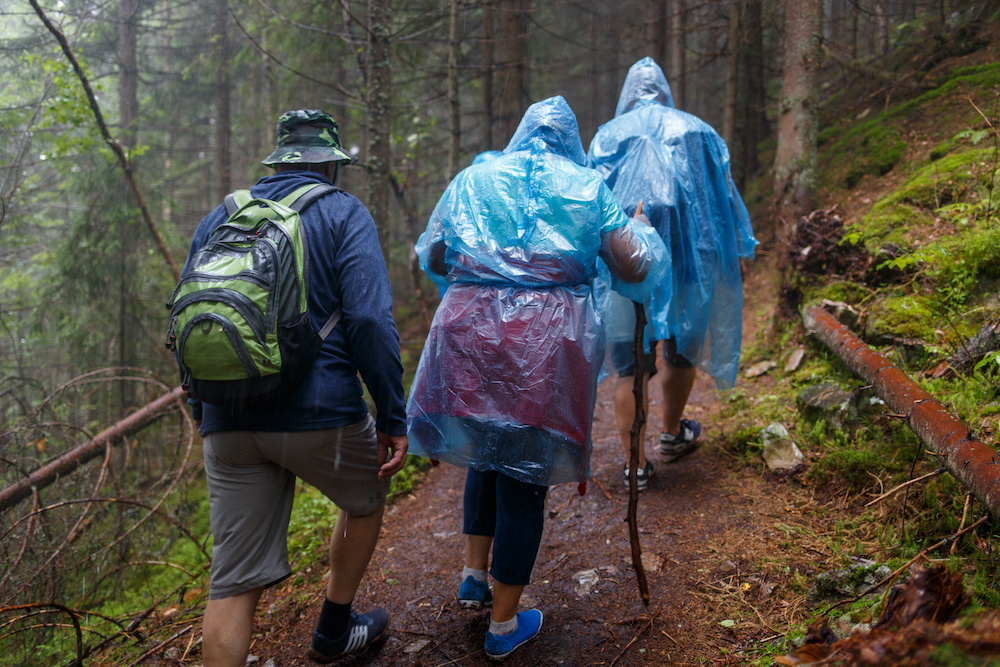
Nothing connects you more with Mother Nature than taking off into the outdoors on a hike.
Let’s face it; nature displays its utmost splendor and beauty only while it’s raining.
If you appreciate the husky, earthy smells combined with a constant pitter-patter in the background, hiking in the rain is the ideal sport for you.
However, along with your passion and determination for the wet weather, you’ll need to make other preparations before you hike in the rain.
This includes rounding up proper hiking rain gear, appropriate clothing, and essential food items.
Is Hiking in the Rain Fun?
Hiking in rain is somewhat the same as hiking at any other time of the year; it's fun and fulfilling.
What Makes It More Fun?
That said, other factors make the hassle worthwhile or make rain hiking fun and memorable, including:
- Isolated Trials
Usually, you’re likely to find a hoard of people on popular hiking destinations.
When the weather starts to look shady, though, nobody is likely to come out and tackle the severe trials.
That means you’ll probably get the trial to yourself, and you can enjoy it to the fullest!
- Astounding Greenery
When the downpour covers the vegetation with a fresh drizzle during the rainy season, you’ll find the plants greener and more beautiful.
If you appreciate the earthy glory of nature, the rainy season is the perfect time for you to go hiking.
- Unique Wildlife Sightings
You should consider setting out for a hike in the rain, especially if you’re a bird-watcher.
Birds love the rainy season because it brings out yummy creepy crawlies for them to devour.
- You Won’t Feel Hot
As a regular hiker, you know how it feels to go through challenging trails with the sun blazing upon your head.
While hiking on a sunny day has its benefits, if you like to be calm and fresh throughout your trip, you should definitely think of walking in the rain.
Is It Dangerous To Hike in the Rain?
Now that you know the benefits that come with hiking in rain, you’re wondering what all the fuss is about?
Why can’t you just get your bag and shoes and set out on your favorite trail while it’s raining?
Some reasons make it challenging and dangerous to hike during this weather.
The Dangers and Challenges
While these dangers or challenges don’t mean you shouldn’t hike in rain at all, you should know them to find out what’s ahead of you.
- Seasonal Rain Can Turn Into a Nasty Storm
The main problem with setting out during dangerous weather is it can change its course anytime, and you can get stuck in a storm.
You should prepare for such a situation and avoid it altogether if you don’t think you’re up to it.
- Slippery Surfaces
Typically, you’ll only come across slippery surfaces while hiking along with marshy areas and streams.
On the contrary, every area will become slippery, including rocks and logs, when it starts to rain.
If you invest in the right rain gear for hiking, though, you should be able to cross slippery surfaces easily.
- Flooded Streams
If you’re planning to hike across streams and creeks, you should know that these bodies of water get flooded and swell up in the rainy season.
It makes them trickier to cross on foot. In this case, all your clothes and hiking gear should be waterproof to avoid any discomfort.

What Do You Wear on a Wet Hike?
Now that you’ve been through both the dangers and the benefits of hiking while it's raining, the prospect might still sound appealing to some of you.
If it does, here are some items you need to invest in to ensure you have the appropriate attire for your wet hike.
Hiking Rain Jackets
The most important piece of clothing while hiking in wet conditions is a rain jacket.
The jacket should be high-quality and made out of durable materials.
If you go out in the rain wearing a low-quality jacket, it won’t be protective enough to keep you safe and dry inside.
Look for one that has reliable waterproofing to keep you dry and fresh for more extended periods.
Besides that, rain jackets come with many other features and enhancements these days.
Consider checking out multiple brands and retailers before making your final purchase.
It's best to get one with armpit zips. This feature keeps you comfortable and doesn’t let you get too sweaty.
Also, make sure your jacket fits you well. If it’s loose or tight, it won’t do its job correctly, and you won’t get sufficient rain protection.
When determining the size, remember that you’ll be wearing some layers inside if you set out during the rain.
That’s why your jacket should have enough space to accommodate the extra layers.
Waterproof Pants
Hiking pants should not only be waterproof but breathable and comfortable as well.
Wearing waterproof pants help you avoid rashes and thigh chafing after you’re done hiking.
We know what you’re thinking. You’ll seldom find waterproof clothing articles that are also breathable.
Try to get the best of both worlds by avoiding completely water-resistant pants.
This way, you’ll get equal amounts of waterproofing and breathability. Keep in mind that these pants won’t be as comfortable as your daily denim.
It can help if you put on some soft leggings underneath the pants to ease the discomfort.
One feature you should look for while buying waterproof pants is whether it has a zipper at the bottom.
These zippers allow you to open the pant legs from the bottom and wear the pants or take them off without removing your shoes.
Gaiters
Gaiters are optional hiking gear, but if you’re setting out for a rain hike, they’re essential for you.
They’re mainly items that you can wrap around your lower legs to keep your socks dry from the inside.
Gaiters will help you remain comfortable by keeping mud and water out of your shoes.
Hiking Boots
If you’re a hiker, you probably have a pair of hiking boots already. But, there’s a chance your current hiking boots are not made for rainy hikes.
Like any other hiking rain gear, your hiking boots should be waterproof.
Additionally, the ideal shoes to wear in this weather are high ankle boots.
This keeps water and mud from seeping inside your shoes and getting your feet wet.
We all know that once your feet are wet, you cannot go further on your hike.
To avoid that, it’s a great idea to pack an extra pair of socks with you to change in case your feet get wet.
You should also consider getting trail running shoes over hiking boots for wet hiking.
That’s because these shoes are light and quick-drying, making them a better option than traditional hiking boots.
Other Clothing Tips
No matter how many waterproof clothing articles you invest in, you'll get wet sooner or later during your rainy hike.
Hence, concentrate on dressing warm and light to avoid getting uncomfortable on trial.
Here are some tips you should follow while setting up your rain gear for hiking.
- Avoid Cotton and Denim
These materials get very heavy and cold when they’re wet.
You don’t want to carry the extra weight on your body while you’re already struggling with a challenging trial.
Instead, choose moisture-wicking, light materials that don’t get bulky when wet but dry out quickly.
- Wear a Thin Base Layer
Your base layer must be warm enough to get you through the cold weather.
Consider wearing wool as the first or mid-layer.
Apart from that, you can go for a polyester or synthetic material that dries quickly and keeps you warm.
- Have a Waterproof Backpack
Once you have your clothes ready, the next step is to pack your backpack to take along on your rainy hike.
First of all, you should check if your backpack is waterproof. You don’t want your extra clothes and belongings to get wet inside.
Remember, your usual hiking bag is not entirely waterproof.
There are many points, including the quick access flaps, pull-chords, and zippers from where water can easily seep through.
In this case, you should try waterproofing your bag yourself. You can do this by fitting the entire bag into a rain cover.
Still, the rain cover will only work when there is a drizzle. In the case of heavy rainfall, large water droplets will seep through the cover into your bag anyway.
In such situations, you should waterproof your backpack and your belongings internally.
The best way to do this is by lining your bag initially with a large plastic bag before placing your things inside.
After that, keep all your belongings in zip-lock bags before you transfer them into your backpack.
Other Essential Items
After your attire and your backpack, the essential rainy day hiking gear comes next.
While these pieces of equipment may come in handy on any other hike you take, they’re highly crucial during rainy weather.
Handwarmers
Warm head caps are usually considered an accessory for skiing and snow sports.
However, if you’re heading out for a hike in heavy rain, you’ll need to stay as warm as you can.
Wearing a simple head warmer can help keep your body heat in and keep you energetic throughout the trial.
Blister Care
Usually, hikers carry blister prevention supplies with them on every hike.
Since wet feet are more likely to get blistered, you should carry extra blister prevention supplies with you, just in case.
Headlamp
The rainy season is known to make conditions dark and gloomy.
Even if you’re not planning an overnight hike, take a headlamp along with you to help in case it gets too dark.
Map Case
What if you get lost while hiking on a rainy day? As we mentioned, you will hardly find other hikers around to help you out.
That’s why you should keep your map from getting wet at all costs.
Invest in a sturdy map case so that your map stays dry and usable at all times.
Hiking Poles
Hiking poles are necessary while rain hiking. The ground will be quite slippery and wet so you can use these poles for extra stability.
You can also use hiking poles to check the depth of puddles that come your way for extra precaution.
Safety FAQs
Once you’ve rounded up the ideal clothes and essential gear, you’re ready to get out there and enjoy your favorite weather.
To make sure you’re fully prepared, we answered some safety-related questions that you can consider as extra hiking in the rain tips.
1. How Do I Keep My Feet Dry While Hiking in the Rain?
There are many ways you can keep your feet dry during your rainy season hike. These include:
- Wearing quick-drying socks
- Wearing high-ankled boots
- Using gaiters
- Putting on thin, neoprene trail shoes instead of heavy hiking boots
2. How Do You Avoid Lightning While Hiking?
To avoid lightning, stay away from trees and other tall objects at all costs.
Besides that, if you carry metal objects like hiking poles, keep them at least ten feet away from you so that you don’t get struck through the items.
Most importantly, whenever you hear lightning, take cover, and move further only when the weather is calm again.
3. How Can You Constantly Monitor the Weather?
Carry communication devices and keep checking weather updates.
If things are about to get worst, the best choice is to return home.
Why Conduct Self-Assessment?
While you’re busy hiking, you can easily forget about replenishing your body.
Stay hydrated at all times and if you start feeling cold, grab a snack immediately.
Hiking in the Rain Tips: The Conclusion
Even if you take all the precautions, the central aspect of enjoying your rainy season hike is by keeping a positive mindset.
If you’re passionate about witnessing the rainy weather hands-on, you should be prepared for handling the hardships that come with it.
Just prepare yourself properly by rounding up the right attire and other essentials and focus on enjoying your hike to the optimum level.
